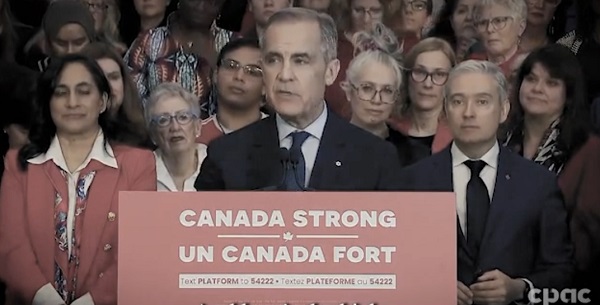Economy
Ottawa’s cap-and-trade plan long on costs, light on environmental benefits

From the Fraser Institute
” the Trudeau government’s new plan would reduce an already unmeasurable climate benefit to one even less measurable “
On Thursday, the Trudeau government unveiled its plan to cap greenhouse gas emissions from Canada’s oil and gas sector. The plan calls for a “cap-and-trade” system rather than a mandatory hard cap on emissions.
A previous plan would have required the oil and gas sector to reduce emissions by 42 per cent (from 2019 levels) by 2030. The new plan calls for a 35 per cent to 38 per cent cut (again, compared to 2019 levels by 2030). So the government has somewhat softened the target. However, the slight change is unlikely to improve the cost/benefit analysis for the sector or affected provinces.
As noted in a study published earlier this year, the Trudeau government’s previous plan would have resulted in at least $45 billion in revenue losses for the oil and gas sector in 2030 alone, which would imply a significant drop resource royalties and tax revenue for governments. And costs would ripple farther out from the oil and gas sector, into the plastics and petrochemical sectors, imposing more costs and threatening the employment of many Canadian workers in those sectors.
Crucially, according to the study, this economic gain would come with little or no environmental benefit. While the reductions would be large when only considering Canada’s oil and gas sector, the impact on climate change, which is a matter of global GHG concentrations, would be virtually nonexistent. The government’s previous plan called for Canada to reduce GHG emissions by 187 megatonnes in 2030, which would equate to four-tenths of one per cent of global emissions and likely have no impact on the trajectory of the climate in any detectable manner and hence offer equally undetectable environmental, health and safety benefits. In other words, the Trudeau government’s new plan would reduce an already unmeasurable climate benefit to one even less measurable.
And now, there are serious questions if the new plan will deliver even the miniscule climate benefit mentioned above. Under a cap-and-trade scheme, companies can trade in emission offsets if they’re unable to reduce emissions via their own technological processes, and to avoid cutting oil and gas production. But emission offset schemes are deeply dodgy.
As noted in a Guardian investigation of Verra, the world’s leading offset market—basically, organizations that reduce carbon in the atmosphere by tree-planting and other initiatives—more than 90 per cent of Verra’s rainforest offset credits (among the most commonly used by companies) are likely “phantom credits” and do not represent genuine carbon reductions. And as reported in the ultra-green Grist, rainforest credits are not the only bogus game in town. “In reality… the market for these offsets is ‘riddled with fraud,’ with offset projects too often failing to deliver their promised emission reductions.”
Canada’s domestic carbon offset market may be more robust than in other countries, but there’s no guarantee. If a significant share of Canada’s offsets prove to be as bogus as the international norm, GHG reductions from the oil and gas sector might be smaller still.
The Trudeau government’s new GHG cap on the oil and gas sector is a moderate improvement over the previous plan. The cap is a bit less stringent, and therefore might be easier to attain. And the use of cap-and-trade rather than a hard cap will give the oil and gas industry more flexibility, and more importantly, allow it to avoid curtailing production to satisfy the cap. But the plan still fails a critical cost/benefit analysis. It remains quite high in potential costs for Canada’s oil and gas sector, particularly in provinces which produce the most oil and gas, yet will deliver environmental benefits that are too small to measure.
Author:
Economy
The Net-Zero Dream Is Unravelling And The Consequences Are Global

From the Frontier Centre for Public Policy
The grand net-zero vision is fading as financial giants withdraw from global climate alliances
In recent years, governments and Financial institutions worldwide have committed to the goal of “net zero”—cutting greenhouse gas emissions to as close to zero as possible by 2050. One of the most prominent initiatives, the Glasgow Financial Alliance for Net Zero (GFANZ), sought to mobilize trillions of dollars by shifting investment away from fossil fuels and toward green energy projects.
The idea was simple in principle: make climate action a core part of financial decision-making worldwide.
The vision of a net-zero future, once championed as an inevitable path to global prosperity and environmental sustainability, is faltering. What began as an ambitious effort to embed climate goals into the flow of international capital is now encountering hard economic and political realities.
By redefining financial risk to include climate considerations, GFANZ aimed to steer financial institutions toward supporting a large-scale energy transition.
Banks and investors were encouraged to treat climate-related risks—such as the future decline of fossil fuels—as central to their financial strategies.
But the practical challenges of this approach have become increasingly clear.
Many of the green energy projects promoted under the net-zero banner have proven financially precarious without substantial government subsidies. Wind and solar technologies often rely on public funding and incentives to stay competitive. Energy storage and infrastructure upgrades, critical to supporting renewable energy, have also required massive financial support from taxpayers.
At the same time, institutions that initially embraced net-zero commitments are now facing soaring compliance costs, legal uncertainties and growing political resistance, particularly in major economies.
Major banks such as JPMorgan Chase, Citigroup and Goldman Sachs have withdrawn from GFANZ, citing concerns over operational risks and conflicting fuduciary duties. Their departure marks a signifcant blow to the alliance and signals a broader reassessment of climate finance strategies.
For many institutions, the initial hope that governments and markets would align smoothly around net-zero targets has given way to concerns over financial instability and competitive disadvantage. But that optimism has faded.
What once appeared to be a globally co-ordinated movement is fracturing. The early momentum behind net-zero policies was fuelled by optimism that government incentives and public support would ease the transition. But as energy prices climb and affordability concerns grow, public opinion has become noticeably more cautious.
Consumers facing higher heating bills and fuel costs are beginning to question the personal price of aggressive climate action.
Voters are increasingly asking whether these policies are delivering tangible benefits to their daily lives. They see rising costs in transportation, food production and home energy use and are wondering whether the promised green transition is worth the economic strain.
This moment of reckoning offers a crucial lesson: while environmental goals remain important, they must be pursued in balance with economic realities and the need for reliable energy supplies. A durable transition requires market-based solutions, technological innovation and policies that respect the complex needs of modern economies.
Climate progress will not succeed if it comes at the expense of basic affordability and economic stability.
Rather than abandoning climate objectives altogether, many countries and industries are recalibrating, moving away from rigid frameworks in favour of more pragmatic, adaptable strategies. Flexibility is becoming essential as governments seek to maintain public support while still advancing long term environmental goals.
The unwinding of GFANZ underscores the risks of over-centralized approaches to climate policy. Ambitious global visions must be grounded in reality, or they risk becoming liabilities rather than solutions. Co-ordinated international action remains important, but it must leave room for local realities and diverse economic circumstances.
As the world adjusts course, Canada and other energy-producing nations face a clear choice: continue down an economically restrictive path or embrace a balanced strategy that safeguards both prosperity and environmental stewardship. For countries like Canada, where natural resources remain a cornerstone of the economy, the stakes could not be higher.
The collapse of the net-zero consensus is not an end to climate action, but it is a wake-up call. The future will belong to those who learn from this moment and pursue practical, sustainable paths forward. A balanced approach that integrates environmental responsibility with economic pragmatism offers the best hope for lasting progress.
Marco Navarro-Genie is the vice president of research at the Frontier Centre for Public Policy. With Barry Cooper, he is coauthor of Canada’s COVID: The Story of a Pandemic Moral Panic (2023).
Alberta
CPP another example of Albertans’ outsized contribution to Canada

From the Fraser Institute
By Tegan Hill
Amid the economic uncertainty fuelled by Trump’s trade war, its perhaps more important than ever to understand Alberta’s crucial role in the federation and its outsized contribution to programs such as the Canada Pension Plan (CPP).
From 1981 to 2022, Albertan’s net contribution to the CPP—meaning the amount Albertans paid into the program over and above what retirees in Alberta received in CPP payments—was $53.6 billion. In 2022 (the latest year of available data), Albertans’ net contribution to the CPP was $3.0 billion.
During that same period (1981 to 2022), British Columbia was the only other province where residents paid more into the CPP than retirees received in benefits—and Alberta’s contribution was six times greater than B.C.’s contribution. Put differently, residents in seven out of the nine provinces that participate in the CPP (Quebec has its own plan) receive more back in benefits than they contribute to the program.
Albertans pay an outsized contribution to federal and national programs, including the CPP because of the province’s relatively high rates of employment, higher average incomes and younger population (i.e. more workers pay into the CPP and less retirees take from it).
Put simply, Albertan workers have been helping fund the retirement of Canadians from coast to coast for decades, and without Alberta, the CPP would look much different.
How different?
If Alberta withdrew from the CPP and established its own standalone provincial pension plan, Alberta workers would receive the same retirement benefits but at a lower cost (i.e. lower CPP contribution rate deducted from our paycheques) than other Canadians, while the contribution rate—essentially the CPP tax rate—to fund the program would likely need to increase for the rest of the country to maintain the same benefits.
And given current demographic projections, immigration patterns and Alberta’s long history of leading the provinces in economic growth, Albertan workers will likely continue to pay more into the CPP than Albertan retirees get back from it.
Therefore, considering Alberta’s crucial role in national programs, the next federal government—whoever that may be—should undo and prevent policies that negatively impact the province and Albertans ability to contribute to Canada. Think of Bill C-69 (which imposes complex, uncertain and onerous review requirements on major energy projects), Bill C-48 (which bans large oil tankers off B.C.’s northern coast and limits access to Asian markets), an arbitrary cap on oil and gas emissions, numerous other “net-zero” targets, and so on.
Canada faces serious economic challenges, including a trade war with the United States. In times like this, it’s important to remember Alberta’s crucial role in the federation and the outsized contributions of Alberta workers to the wellbeing of Canadians across the country.
-

 2025 Federal Election2 days ago
2025 Federal Election2 days agoCarney’s Fiscal Fantasy: When the Economist Becomes More Dangerous Than the Drama Teacher
-

 International15 hours ago
International15 hours agoPope Francis has died aged 88
-

 2025 Federal Election14 hours ago
2025 Federal Election14 hours agoCarney’s budget means more debt than Trudeau’s
-

 2025 Federal Election2 days ago
2025 Federal Election2 days agoA Perfect Storm of Corruption, Foreign Interference, and National Security Failures
-

 Business15 hours ago
Business15 hours agoCanada Urgently Needs A Watchdog For Government Waste
-

 2025 Federal Election2 days ago
2025 Federal Election2 days agoCampaign 2025 : The Liberal Costed Platform – Taxpayer Funded Fiction
-

 Energy15 hours ago
Energy15 hours agoIndigenous-led Projects Hold Key To Canada’s Energy Future
-

 International11 hours ago
International11 hours agoPope Francis Dies on Day after Easter







